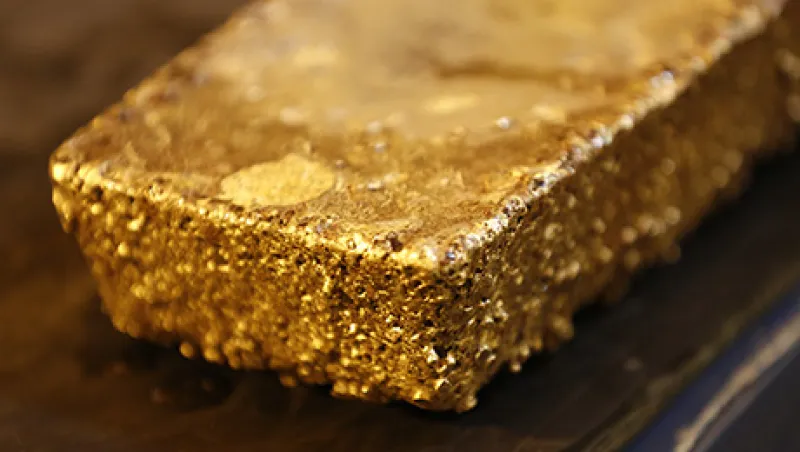SPDR Gold Trust ETF (GLD) revolutionized gold trading when it launched ten years ago. It paved the way for all other precious metals exchange-traded funds and their leveraged varieties. Before GLD debuted, exposure to gold came in bars, coins, certificates, savings plans or shares in gold-mining companies. The ETF put precious metals investing into the mainstream and eliminated headaches from insurance, shipping and storage vaults.
The ETF amassed more than $1 billion in assets in its first three days, starting November 18, 2004, which sealed its place in history as the fastest an ETF has ever attracted that level of assets. Within 15 months, it had raked in $5 billion, and within three years, it had $10 billion.
“It changed the gold market rather dramatically,” says Dennis Gartman, the commodities analyst and newsletter writer who helped create a number of gold and currency ETFs: AdvisorShares Gartman Gold/Yen ETF (GYEN), Gartman Gold/British Pound ETF (GGBP) and Gartman Gold/Euro ETF (GEUR). “It broadened the market,” he says. “It made it far more transparent. It made it easier for the public to get in and to get out.”
As the largest precious metals ETF, GLD accounts for 80 percent of assets invested in physically backed gold ETFs in the U.S. and half of gold ETFs globally, according to the World Gold Council. Near the height of the gold market in 2011, GLD briefly overtook the SPDR S&P 500 ETF (SPY) as the world’s largest ETF, when it had $76.7 billion in assets. It has since fallen in the rankings to the ninth-largest U.S.-traded ETF, with $28 billion in assets.
With 723 metric tons, GLD owns more of the yellow metal than the European Central Bank and India combined. But that’s just a nugget compared with the 1,200 tons Chinese buyers accumulated in 2013 and a mere flake compared with the global jewelry market, which is estimated at 84,300 tons, and the industrial market at 20,800 tons.
GLD, with about 1 million shareholders, can be found in risk-averse pension portfolios and high-rolling hedge funds alike. The Teacher Retirement System of Texas owns $52 million worth. Commonwealth of Pennsylvania Public School Employees’ Retirement System has $42 million. Hedge fund Paulson & Co., famed for correctly betting on the housing crash, holds 10.2 million shares valued at $1.17 billion.
GLD probably boosted bullion prices and increased market volatility by making gold a legitimate asset class held in pension funds and retirement accounts, says Thomas Winmill, a specialist in precious metals and natural resources investing as portfolio manager of the Midas Fund (MIDSX), with $15 million in assets under management.
“Pools of capital that would not otherwise consider using gold in a portfolio now do,” says Winmill. “It’s a mixed blessing to have. There are greater numbers of buyers, but there could also be greater number of sellers when there’s a panic.”
However, Terry Sacka, chief strategist of Cornerstone Asset Metals, believes gold’s price would be much higher without the advent of gold ETFs, which offer a means of paper trading a physical commodity.
“We believe the current derivative naked-short position in ETF and futures markets for gold to be in the area of 90 ounces of paper sold for every one real ounce in the registered vaults,” Sacka writes in an e-mail. “Mind you, most deep physical professionals are skeptical the real gold is there to back up the ETF, as it is claimed to be.”
Nevertheless GLD represents a hard, tangible asset with intrinsic value, unlike currencies and stocks, which on occasion have become worthless. Central banks cannot create more gold by firing up the printing presses, as they do fiat currencies.
“Gold is a store of value because gold will never go to zero,” Miguel Perez-Santalla, sales and marketing manager of Heraeus Metals New York, writes in an e-mail. “All other financial instruments can. It is not a classical investment; it is more of an insurance policy.”
Whereas those distrustful of paper currencies see it as a currency that’s been used for centuries, the Internal Revenue Service treats GLD as a collectible.
Gold offers asset diversification in a portfolio as it moves independently from stocks and bonds. Over the past ten years, it has a correlation ratio of 0.09 with SPY and iShares 20-Year Treasury Bond ETF (TLT).
GLD has returned 9.8 percent annualized, versus 7.9 percent for SPY, over the past ten years (through October 19). However, it has severely lagged the stock market over the past five-, three- and one-year periods. The goldbugs would contend that it’s long overdue to outperform simply because of mean reversion.






